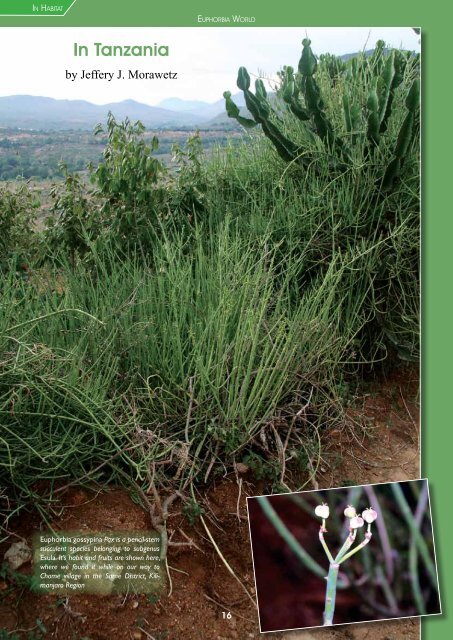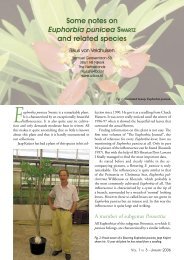In Tanzania - International Euphorbia Society
In Tanzania - International Euphorbia Society
In Tanzania - International Euphorbia Society
You also want an ePaper? Increase the reach of your titles
YUMPU automatically turns print PDFs into web optimized ePapers that Google loves.
in habitat<br />
<strong>In</strong> <strong>Tanzania</strong><br />
by Jeffery J. Morawetz<br />
<strong>Euphorbia</strong> gossypina Pax is a pencil-stem<br />
succulent species belonging to subgenus<br />
Esula. It’s habit and fruits are shown here,<br />
where we found it while on our way to<br />
Chome village in the Same District, Kilimanjaro<br />
Region<br />
<strong>Euphorbia</strong> World<br />
16
<strong>In</strong> Vol. 6(3) Jeffery J. Morawetz took<br />
us on a journey to Tanzanzia. Now<br />
he adds some more pictures to show<br />
us the wealth of <strong>Euphorbia</strong> species to<br />
be found in this East African country.<br />
Acknowledgements: William<br />
Kindeketa, Haji Suleiman, Neduvoto<br />
Mollel, Flora Ismail, Roy Gereau,<br />
COSTECH & the <strong>Tanzania</strong> Botanical<br />
Research and Conservation Programme.<br />
<strong>Euphorbia</strong> buruana Pax is a strongly<br />
winged species in the spine-shield group<br />
(subgenus <strong>Euphorbia</strong> section <strong>Euphorbia</strong>).<br />
This specimen was collected not far<br />
from E. gossypina en route to Chome village.<br />
<strong>Euphorbia</strong> World<br />
Also en route to Chome, we came across these nice specimens of the arborescent<br />
spine-shield species <strong>Euphorbia</strong> nyikae Pax ex Engl. The spine-shield<br />
<strong>Euphorbia</strong> species often have unornamented yellow cyathial glands, as<br />
shown here, and in E. buruana.<br />
17<br />
17<br />
<strong>Euphorbia</strong> SEEd in habitat atlaS<br />
Vol. 7 n. 3 - dEcEmbEr 2011
in <strong>Euphorbia</strong> habitat<br />
SEEd atlaS<br />
The road to Chome was filled with <strong>Euphorbia</strong>!<br />
Here we have the shrubby E. cuneata Vahl with<br />
its characteristic spine-tipped branches. This species<br />
belongs to subgenus Rhizanthium. Check<br />
out those cup-like green cyathial glands!<br />
18<br />
Here we have the herbaceous <strong>Euphorbia</strong><br />
crotonoides subsp. crotonoides Boiss.,<br />
a member of subgenus Rhizanthium. This<br />
species was collected in the western Rukwa<br />
Region, between Sumbawanga and Mpanda.
<strong>Euphorbia</strong> World<br />
<strong>Euphorbia</strong> SEEd in habitat<br />
atlaS<br />
One of my favourite species of all, <strong>Euphorbia</strong> neospinescens Bruyns<br />
(formerly Monadenium spinescens (Pax) P.R.O.Bally) was collected in the<br />
Morogoro Region. It was particularly difficult to collect: not only are the<br />
stems heavily armed with spines, the leaf margins and midrib also bear<br />
sharp points!<br />
19<br />
Finally, here is a shot of the typical orange soils and hills around<br />
Same. There are several <strong>Euphorbia</strong> heterochroma Pax scattered<br />
in the foreground. Same District was great for <strong>Euphorbia</strong>: we collected<br />
nine different species in just four hours!<br />
Vol. 7 n. 3 - dEcEmbEr 2011




